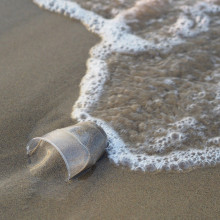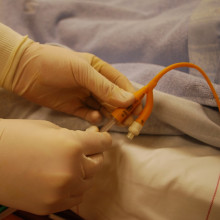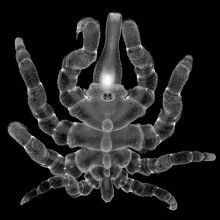The plan to pay people to dial down their electricity use, the bacteria eating plastic in the ocean, and why antidepressants make it harder for users to enjoy themselves.
In this episode

00:51 - Being paid to turn off your power
Being paid to turn off your power
Simon Harrison, Mott MacDermott
The collision of an energy crisis arising from Russia's invasion of Ukraine, decommissioning of our ageing fossil fuel-powered fleet of power stations, lofty net zero goals, and some very cold snaps with very little wind this winter has seen the ability of the National Grid to maintain electricity supplies reach near breaking point at times. This has prompted blackout warnings, a surge in enquiries for backup battery installations, and now initiatives to pay a million UK customers to turn off their washing machines and other luxury appliances at peak times to unload the supply. So how does this work, and is it the first step towards centralised digital control of our energy consumption, which, after dropping for years as technology improved efficiency, now looks set to climb again as more of us switch to electric vehicles, and home heat pumps? I put these points to Simon Harrison, who is group head of strategy at engineering company Mott MacDondald and chaired the Department for Business, Energy & Industrial Strategy Electricity Engineering Standards Review in 2019...
Simon - In a market that is a little short of electricity, it's not a crisis point. There is a choice between running expensive power stations to cover demand peaks or reducing the demand. And National Grid is, I think, really experimenting with reducing the demand and testing the appetite of that amongst people like you and me.
Chris - Previously, they'd have just done that by whacking the price up. The price has gone up, but they're going further.
Simon - Yes. And domestic consumers would not normally see a change in the value price or the special arrangements that National Grid has to manage demand peaks that consumer tariffs normally flat across time. What's changed? Natural grid is looking to the future where there are even more renewables than now. And also where demand potentially has much greater components of things like electric vehicle charging in it. It's foreseeing situations where covering the demand peaks with additional power generation starts to become much more expensive. And so the opportunity to try consumers reducing their demands in accordance to, if you like, system signals is potentially really interesting. And it's what National Grid is experimenting with, I think.
Chris - Are you saying then that we're in a position where we're actually potentially gonna see bigger surges because of changing patterns of use with people plugging in energy hungry cars? And if they avoid doing that all at once? That's what we're striving for here, because overall our energy use has gone down, hasn't it? As we've embraced more efficient technologies.
Simon - Energy use has gone down over time, but we're expecting that to go up as more and more gets electrified from other sources of energy. Especially electric vehicles, but also potentially electric heat pumps for heating. So overall the demand, if it was uncontrolled, could get a lot more peaky, which then starts to become a lot more expensive to service.
Chris - In the past in order to anticipate everyone getting home for work in the evening, putting the oven on, putting the lights on, et cetera. They've revved up more power stations, so what's different this time?
Simon - So that could still be done. And there are a number of coal fired power stations being held in warm reserves as I understand right now, in case they're needed. But this is really to explore alternatives to that which should be rather lower cost, which is to persuade people to use less electricity at critical times.
Chris - How are they doing that?
Simon - It's being done by smart meters in people's homes where, if people give permission, National Grid can see half value data from the smart meter and can therefore determine whether consumption has been reduced.
Chris - The problem is if everyone turns things off, because it's a window period of time, they're asking people to cut their usage by a significant amount over that time, isn't it? Does that not mean that loads of stuff comes back on after that downtime is off and that's gonna create a massive surge on the grid and then they've traded one problem for another?
Simon - Well, the grid is designed to cope with moderate levels of surge like that. And I think the size of this experiment has been contained so that this is manageable essentially,
Chris - What have been the outcomes? Is it working?
Simon - I'm not sure the data's out there actually at the moment, but I think what's really interesting is, going forward into the future, I think a lot more of this is likely to be automated. So it's not going to be so much a matter of individuals going around switching things off, but it's going to be about people contracting for their electricity in different ways. That means that this happens seamlessly at certain times. Perhaps people will get notices on their mobile phones, will be invited to opt in or opt out, and they won't themselves then have to take action with things like turning off their electric vehicle charger.
Chris - Is there going to be almost like a priority pecking order in the home where your fridge freezer might get first dibs on a certain residual supply of energy, but then there are certain luxury items, certain types of lighting, hot water heater for example, where it's not life or death if they're suspended for a while and your electricity company might have the ability to switch some of those things down temporarily just just to smooth out supplies. So rather than managing supplies, which we've done in the past, now we're managing demand.
Simon - So as we get to a much more digitized system, those kinds of things become possible. And you might be able to sign up for contracts that do that. I think actually your fridge freezer would be amongst the easiest things to switch off for a period of time as that wouldn't really affect very much at all. But you might not want your TV to be switched off, so there would be some sort of implied pecking order within a much more digital home.

06:51 - Bacteria responsible for lost ocean plastic
Bacteria responsible for lost ocean plastic
Maaike Goudriaan, Royal Netherlands Institute for Sea Research
Since 2005, marine biologists have had a problem to solve. When taking samples from the ocean, they find they are finding a lot less plastic than they would expect given the amount being dumped into the sea every year. Over the past decade and a half, a few explanations have arisen for this “plastic paradox”. Some plastics sink and end up buried at the bottom, unmeasured. UV light from the sun also contributes to the break up of some polymer chains, accounting for another chunk of the plastic deficit. But a significant proportion might also be being digested by bacteria. Maaike Goudriaan at the Royal Netherlands Institute for Sea Research has been studying the bacterium Rhodococcus ruber, which appears to be able to break down about 1% of the available plastic per year…
Maaike - We used a plastic that has specific labeled carbon isotopes, so-called carbon 13. So because these carbon atoms in the plastic are labeled, we can follow these labeled carbons. So from that, we knew that the bacterium was able to convert the polymer all the way into CO2, which is the final step in the degradation. This is the smallest part they would typically make out of plastics. And then also the labeled carbon, we found it back in the bacterial cells. The fact that we found it there means that they have actually eaten it and use it as a resource to grow.
James - So you're able to prove in the laboratory that this is what was going on, that this bacteria is able to take the plastic. So the question then becomes whether this could be a real solution to the problem of plastic pollution. Could we just colonize the sea with as many of these bacterias as we can possibly produce?
Maaike - Well unfortunately not. I mean, I get this question quite often and it would be very nice. Unfortunately. I can imagine this might be hard to picture. The oceans are very, very vast. There's a lot of currents we can't influence, and we would be talking about huge amounts of bacteria we would need to grow. So personally I would also see a large logistics problem.
James - Fair enough. But how can we use this information? The characteristics of the Rhodococcus ruber?
Maaike - Our main goal was to develop this new method to measure plastic degradation. And the reason we wanted to do that is that typically in marine environments, if plastic disappears, it seems to be very, very slow. And you can imagine that if degradation goes very slow, it might be difficult to accurately measure a difference in weight. And indeed what we also found is that Rhodococcus ruber is able to break down the polyethylene, so the plastic that we use, with a rate of 1% per year. So that's not a lot. We now know that this method works and that it can be used to measure very small degradation rates. So in that way, in the future, we would like to take samples from water column samples and also sediment samples from the sea and methods to investigate how fast plastic disappears under microbes. And with that, we hope to solve the puzzle of where the plastic goes a little bit further.

10:59 - New catheter material to prevent infections
New catheter material to prevent infections
Andrew Hook, University of Nottingham
Up to one in five hospitalised patients ends up needing a urinary catheter at some point, and with that comes a considerable risk of infection that prolongs hospital stays, drives up healthcare costs and can even be life threatening. Now a team at Nottingham University have discovered a new material that we might be able to use to coat catheters and possibly other medical instruments to prevent infection-causing bacteria from latching on and causing infection in the first place. Andrew Hook…
Andrew - This is a big problem for the NHS. It costs them about 2 billion a year to treat this biofilm. In fact, about 75 to 80% of hospital acquired infections are associated with catheters particularly as well. And so, we are really interested in trying to prevent bacterial infections associated with the use of urinary catheters.
Chris - Is that through making those devices harder for the microbes to gain a toehold on in the first place? Or is it through making them poison the microbes so that they don't gain a toe hold? Or both?
Andrew - Both approaches are used. So we try to poison or kill the bacteria. Actually this is the approach that people originally took, but hasn't shown any clinical efficacy. It doesn't work in hospitals. And so our approach was to stop the bacteria trying to, as you said, get a toe hold or particularly to form biofilm, which is this defense mechanism that bacteria have where they form a community. I kind of think of this as the same way that you might see buffalo out in Africa, they form a cluster that prevents the lions from being able to attack, and that's exactly what biofilms do where the immune system can't attack them. But our coating stops the bacteria from being able to do that and allows the immune system to clear them out.
Chris - Tell us about the coating then. What have you actually discovered?
Andrew - We've actually been working at trying to produce a coating that prevents the biofilm for a while. There's a few strategies that the bacteria can use to cause infection. So ones biofilm, which I've talked about. Another one is bacteria and particularly a species called Proteus mirabilis is able to do this swarming where it forms this raft of bacteria, which is able to travel up the catheter to the bladder and cause an infection. And so we'd already actually found a solution to the biofilm, but we hadn't found a solution to the swarming. We've been trying to do that and we ended up finding a polymer that can prevent the swarming but then couldn't prevent the biofilm. In this work, we've been able to combine those two together to develop a coating, which is able to address all the problems and overcome all the strategies that bacteria used to cause infection. So we can prevent biofilm, we can prevent swarming.
Chris - So under normal circumstances, quite a high fraction of patients in hospital will at some point need a catheter put in to drain urine. And because we've got something connecting the outside world to the inside, that is a superhighway for microbes to crawl up. And you are saying you have erected a roadblock that would give the M6 a run for its money that stops them getting in because they get hold of it.
Andrew - Yeah, exactly. They can't get in and then they can't get a foothold there. And it's a case of patients who do have catheters, there's a 3% chance of them developing an infection and that's cumulative. So after two days at 6%, three days, 9% goes up. After 30 days almost a hundred percent of patients get infections. And so yeah, we really think that we are causing a real, as you say, roadblock of bacteria being able to do that.
Chris - Those are big numbers, aren't they? How have you done this then? How did you find the right recipe for something that would work as a catheter but will deter microbes in this way?
Andrew - We accepted the fact that we don't actually understand how bacteria interact with materials, and so we couldn't really design a coating just from our understanding. And so we've used a high throughput approach where we try to screen as many different things as we can and then identify the ones that work. And so that's what we've been able to do. So we have this high throughput screen approach. We screen, hundreds in fact, thousands of different materials. We're able to quickly find the ones that work.
Chris - How good is what you found?
Andrew - Yeah, we're really pleased that we're able to produce a coating that is able to really get around all the different strategies that bacteria have. And particularly in the case of the swarming and preventing the really rapid bacterial movement, there really isn't another strategy that exists. And so we are really excited that we are able to find that. So we reduce the bacterial biofilm formation 99%. So we see a 99% reduction. And I think the bacteria that remain are still in this single bacteria form. So they get cleaned up by the immune system really well, which is really great. We're really excited. That has translated to clinical success as well. We are able to see a reduction in infection clinically, which is really exciting.
Chris - I thought microbiologists were very used to talking in terms of killing 99.9% of bacteria, but I'll settle for 99% in the meantime. You mentioned that one of the reasons why you took the approach, you did just brute force, try lots of chemicals until you find one that's a good hit. Does the fact you've now found one mean that we've now got a new avenue to explore understanding how it's doing that, which might give us clues as to how the bacteria do or don't traverse various surfaces and that might open the door to other treatments?
Andrew - Yeah, absolutely. I think that's a really good point. You know, we started from a position of not understanding the bacteria and the way that they interact with materials. And now we've done all these tests actually, we can use that to try and help ourselves understand the way that bacteria interact and then be able to engineer and design materials that actually work even better than the ones that we've found. So that is certainly a part of what we are trying to do. I think we've been able to identify a new class of materials with antibacterial properties and I think can really use that information to try and engineer even better performing materials.

17:00 - Why antidepressants cause emotional blunting
Why antidepressants cause emotional blunting
Christelle Langley, University of Cambridge
According to figures published last year, more than 8 million people in the UK or about 1 person in every eight, used antidepressants in 2022. While these drugs can be very helpful and even a lifeline for some users, many complain that they leave them feeling emotionally blunted: enjoying things seems to be harder than it used to be. Now we think we might be on the way to understanding why: Cambridge University‘s Christelle Langley gave healthy volunteers a course of the common antidepressant escitalopram and tested a range of cognitive functions. She thinks taking the drug made the users’ brains less sensitive to reward signals, making it harder for them to enjoy some activities…
Christelle - Serotonin is the main brain chemical that is affected by selective serotonin re-uptake inhibitors, which is one of the main kinds of antidepressants. And there's been a lot of work in the field examining how serotonin affects cognition, but it's mainly been done acutely, which is single dose or for short term seven day administration. But of course, as we know, patients take these drugs for months and often even years. So because of this we really need to understand the longer term effects. More
Chris - People also say it takes a few weeks before they begin to feel better after they start taking them. So that's important, presumably.
Christelle - Exactly. So typically we say that it takes at least three weeks for these drugs to start working. And this is exactly the time point at which we looked. So, we gave participants either placebo or, as you've mentioned, the SSRI escitalopram for at least 21 days. And the reason we chose escitalopram specifically is it's one of the best tolerated SSRIs. So that was really important to us. And of course, conducting studies in healthy people also allows us to establish what effects might be due to the drug without looking at what's sort of confounded by the disease process.
Chris - You're not muddling up the disease that's underlying this and their inability to enjoy things because of the disease, it's purely the effect the drug has.
Christelle - Exactly that. Yes.
Chris - And what did you find when you tested them and how did you test them?
Christelle - So we used a number of different tests assessing what we called 'cold cognition' and 'hot cognition'. So cold cognition is rational non-emotional cognition and it's things such as attention and memory. Whereas hot cognition is something that has either social or an emotional element. So interacting with friends, anything like that would be hot cognition. And we also specifically looked at reinforcement learning. And this is how we learn from our environment through either rewarding and positive or negative feedback
Chris - So I give you something and you give me something back in return and I think, 'oh, that's good'. And I learn from the fact that when I give you something, I've got something I wanted back. That would be positive reinforcement.
Christelle - Exactly, yes.
Chris - Right. Okay. And how did that work in this task then? Or what difference was there when you do all these things?
Christelle - So in this task, quite interestingly, we actually build in a certain amount of uncertainty. So if you choose the correct stimulus, four out of five times you're told yes you are correct. But actually one out of five times we misleadingly tell you that you are incorrect. And previous studies have shown that patients with depression are overly sensitive to this negative feedback and they incorrectly respond to the task. So they'll actually switch immediately after receiving negative feedback, even though they know that that should be the correct stimulus.
Chris - And what happened with these people who didn't have depression but were taking this antidepressant drug.
Christelle - So this was our key novel finding, was that participants on escitalopram had a lower reinforcement sensitivity and actually we saw it on two different tests of reinforcement learning. So it seems quite a robust finding. And essentially there were no other differences on any of the other hot or cold cognitive tests. And actually this null finding is quite encouraging because it suggests that they don't have, or that serotonin doesn't have, an adverse effect on, cognition generally but it seems to be that there's something quite specific in the way in which people process either negative or positive feedback
Chris - Putting this together, then. Essentially what you are demonstrating is this is how these drugs help people who are depressed. Because if a person is shielded from responding too much to the knocks of life, that stops them feeling so depressed or stops their disease or underlying condition accelerating. But at the same time, if you are too robust against encouragement, which is what also appears to be happening, then you don't enjoy things as much, which is what you found.
Christelle - Yes. So, patients with depression often report hypersensitivity to negative feedback or they have what we call negative attentional biases. So this would be, for example, when a healthy person is walking down the street, they'll focus on all the happy smiling faces around them, whereas someone with depression might focus on that single person that's walking down the street looking sad and upset. So of course dampening down the negative emotions or distress that depressed patients feel might be a therapeutic process and how these drugs are actually working. But because we can't selectively choose the negative emotions, we're unfortunately seems that they're taking away from some of the enjoyments as well. This doesn't necessarily mean that they're not effective, it's just we've now got a little bit more understanding about how these drugs may work. And this will in future allow us to choose better treatment options as well.
Chris - I was going to say, does this give us a framework to try to make either better drugs, because we can look for drugs that don't necessarily have this effect quite so much, or does it enable us to tailor therapy better so that we can try to get some of the positives but minimize this negative effect? Because at the end of the day, people don't want to walk around feeling numb. They want to feel better, but they don't want to feel emotionally numb.
Christelle - No, exactly. So I think the interesting thing is that we need to understand how these drugs work essentially. And this gives us some insight. As I say, the therapeutic process might be the dampening down, but actually this might not be necessary throughout the whole course of treatment. And actually initially, by being able to dampen down the emotions, you can get to a point where something like cognitive behavioral therapy or some of the psychological therapies may be more effective. So we know what we tend to do in CBT is we try and get people to think about things in a more positive light, but these often don't work in very severe patients before medication.

23:19 - Sea spiders can regrow entire organs
Sea spiders can regrow entire organs
Georg Brenneis, University of Vienna
Limb regeneration, or the ability to grow back legs, is not unheard of in the animal kingdom. Some species of salamander can regrow lost limbs, and and perhaps you’ve seen a lizard’s tail fall off and roll around on the floor as the lizard runs away to grow a new one. But the champions of regeneration are sea spiders. These look exactly as you imagine, and not only can they regenerate limbs, but also their digestive tracts and reproductive organs. Some even survive after being cut in half! So what could be behind this amazing regenerative biology? And why don’t we see such a useful adaptation more often, in us humans for instance? The University of Vienna’s Georg Brenneis...
Georg - What we know at this point is what they can do once they have regenerated. So which organ systems are growing back, what structures can be brought back. But how does this happen? That is the question that we still need to answer. And at this stage we don't know the cells, the cell types, underlying this. And we don't know anything about the genetic programs, the developmental programs that are actually driving this. We can, at this stage, just make educated guesses based on studies that have been done on other arthropods. And there have been studies on crustaceans, for example, where they could show, but just for limb regeneration, which is well known, not central body parts, that there are specific cells which may be more limited in what they can do than proper stem cells. Meaning for example, that the muscles that form in the regeneration process, they come from a specific muscle, so-called 'precursor cells'. So that is one cell type that will produce only the muscles. So, and in this case for sea spiders, we have to look potentially for more cell types because we have gut regenerating, we have reproductive organ structures, regenerating and so on.
Will - Given how old arthropods are, I mean they span back to half a billion years old, perhaps some even older, how much of a role in their continuing survival does limb regeneration play?
Georg - It definitely comes in handy, I'd say. And from what I've seen, sea spiders, particularly now we have some fossils, single fossils, that date back more than 400 million years ago and they looked almost exactly the same. So this body plan has been around for a long, long time. So they have been successful in surviving a lot of mass extinction events actually. And I also collected animals in the field after my first observations. And what you see is that more than half, in some species, are regenerating legs when you collect them. Or they have lost them, so half of the specimen. So it's a very common phenomenon and that obviously can help you to continue to stay in the game. If you lose a leg, you can then actually regrow it after a while because if you run out of legs, you cannot move around anymore. You cannot mate and so on. There are also other arthropods for which it's very obvious that this is extremely useful. We have crabs, everybody knows them and they have a preferred breakage point in legs and they basically throw them at you. So it's predator evasion. They really break very, very easily. Also some scent. Petes do that. A lot of legs are going off and then they regrow. So it's predator evasion, which obviously helps survival of the individual and gives you another chance to, to then reproduce later on.
Will - If limb regeneration was so useful and dates back such a long time, why then was this ability to regrow limbs lost in organisms that have evolved since arthropods?
Georg - Yeah, that is a very, very good question. A million dollar question. I'm not sure I can give a fully satisfying answer to that because we normally think that is so advantageous, right? But it does also have costs and evolution will over time always make, so to say, calculations about costs of what you're doing. So if you put a lot of energy into regeneration, that energy can at the same time not be put into reproduction, which is the ultimate goal if you want to do it. So if you then survive, that might help you. But there are different life strategies or life history trades across the animal kingdom where you can see there's some situations where it perhaps doesn't make that much sense. If you look at the trade-offs. For example, if you have a lifecycle where the adult is very short lived and it just reproduces and that's it. So to invest in massive regenerative abilities that then the animal won't survive because it will die anyway before that, that wouldn't make much sense. Also, mammals cannot do it. Birds, they're warm blooded, so their physiology is a little different. They invest a lot of energy into regulating their body temperature, which has many advantages because you're temperature independent or less dependent. An arthropod, for example, cold temperatures mean that you don't move as quickly. So perhaps this is, and I'm shooting out of the hip here, obviously you are more prone to be caught by a predator. But if you're all the time active, which is cost-intensive as such as mammals, then perhaps it doesn't really in the end pay off to put a lot into another very cost-intensive process. So it's multi-factor things that we look at here. I'm pretty sure.










Comments
Add a comment